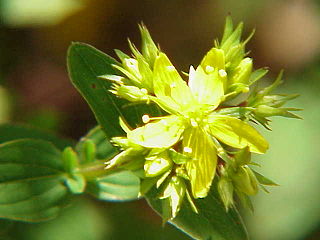
The red-eared slider, also known as the red-eared terrapin, red-eared slider turtle, red-eared turtle, slider turtle, and water slider turtle, is a semiaquatic turtle belonging to the family Emydidae. It is a subspecies of the pond slider. It is the most popular pet turtle in the United States and is also popular as a pet across the rest of the world, and is the most invasive turtle. Because of this, it is the most commonly traded species of turtle in the world.

The crimson rosella is a parrot native to eastern and south eastern Australia which has been introduced to New Zealand and Norfolk Island. It is commonly found in, but not restricted to, mountain forests and gardens. The species as it now stands has subsumed two former separate species, the yellow rosella and the Adelaide rosella. Molecular studies show one of the three red-coloured races, P. e. nigrescens, is genetically more distinct.

The Monimiaceae is a family of flowering plants in the magnoliid order Laurales. It is closely related to the families Hernandiaceae and Lauraceae. It consists of shrubs, small trees, and a few lianas of the tropics and subtropics, mostly in the southern hemisphere. The largest center of diversity is New Guinea, with about 75 species. Lesser centres of diversity are Madagascar, Australia, and the neotropics. Africa has one species, Xymalos monospora, as does Southern Chile. Several species are distributed through Malesia and the southwest Pacific.

Amomum is a genus of plants native to China, the Indian subcontinent, Southeast Asia, New Guinea, and Queensland. It includes several species of cardamom, especially black cardamom. Plants of this genus are remarkable for their pungency and aromatic properties.

Syzygium is a genus of flowering plants that belongs to the myrtle family, Myrtaceae. The genus comprises about 1200 species, and has a native range that extends from Africa and Madagascar through southern Asia east through the Pacific. Its highest levels of diversity occur from Malaysia to northeastern Australia, where many species are very poorly known and many more have not been described taxonomically.

Macrozamia is a genus of around forty species of cycads, family Zamiaceae, all of which are endemic to Australia. Many parts of the plant have been utilised for food and material, most of which is toxic if not processed correctly.

Cenchrus is a widespread genus of plants in the grass family. Its species are native to many countries in Asia, Africa, Australia, the Americas, and various oceanic islands.

The metallic starling, also known as the shining starling, is a bird in the starling family native to the Moluccas, New Guinea, Queensland and the Solomon Islands.

"Jawaharlal Nehru Tropical Botanic Garden and Research Institute", renamed in the fond memory of visionary Prime Minister of India Shri Pandit Jawaharlal Nehru is an autonomous Institute established by the Government of Kerala on 17 November 1979 at Thiruvananthapuram, the capital city of Kerala. It functions under the umbrella of the Kerala State Council for Science, Technology and Environment (KSCSTE), Government of Kerala. The Royal Botanic Gardens (RBG), Kew played an exemplary and significant role in shaping and designing the lay out of the JNTBGRI garden in its formative stages.

Banksia elegans, commonly known as the elegant banksia, is a species of woody shrub that is endemic to a relatively small area of Western Australia. Reaching 4 m (13 ft) high, it is a suckering shrub that rarely reproduces by seed. The round to oval yellow flower spikes appear in spring and summer. Swiss botanist Carl Meissner described Banksia elegans in 1856. It is most closely related to the three species in the subgenus Isostylis.

Clidemia hirta, commonly called soapbush or Koster's curse, is a perennial shrub. It is an invasive plant species in many tropical regions of the world, creating serious damage.

Enneapogon is a cosmopolitan genus of plants in the grass family.
Thelepogon is a genus of Asian, African, and Australian plants in the grass family.

Ptychosperma elegans is a very slender palm endemic to the Northern Territory and eastern Queensland in Australia. It has the common names of Alexander palm, solitaire palm, and elegant palm.
Helicia ferruginea, commonly named hairy honeysuckle or rusty oak, is a species of rainforest trees, of eastern Australia, from the flowering plant family Proteaceae.
Helicia nortoniana, also named Norton's silky oak, is a species of rainforest trees, of northeastern Queensland, Australia, from the flowering plant family Proteaceae.
Dubouzetia is a genus of about eleven species known to science, growing from shrubs up to large trees, in Papuasia and Australasia and constituting part of the plant family Elaeocarpaceae.
C. elegans most commonly refers to the model round worm Caenorhabditis elegans. It may also refer to any of the species below. They are listed, first in taxonomic order and, second, alphabetically.

Hypericum elegans is a species of flowering plant in the St. John's wort family Ericaceae. It is native to Europe.













